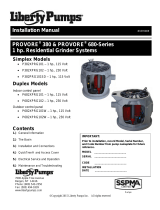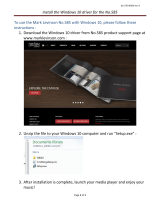
7000 Apple Tree Avenue Bergen, NY 14416 Phone: (800) 543-2550-Fax: (585) 494-1839-www.libertypumps.com
Operation and Maintenance Manual
P
age 8 of 9
DWG#7235000I
Manual 7235000I
:
Operation and Maintenance Manual
Operation and Maintenance Manual
Operation and Maintenance Manual
Testing the complete system
1. Test high oil circuit by lifting the float switch with the sump empty of water. Oil is non conductive like “air”, and
when the float is lifted only the HIGH OIL indicator will be illuminated. The auxiliary contacts in the control panel
and the remote alarm will activate.
2. Test a pump cycle by slowly filling tank with water. Stop filling tank with water when the level touches middle
probe. When the water touches the middle probe, pump should start and pump down to the bottom probe at
which time the pump will stop. Check discharge plumbing for leaks and make sure discharge is going to the
correct area.
3. Test high water circuit. Slowly fill the tank until the water level just touches the upper probe. When the water
touches all probes, the HIGH WATER indicator will be illuminated. The auxiliary contacts in the control panel and
the remote alarm will activate.
4. Test the remote alarm for power loss. Unplug the power cord on the control panel. The auxiliary contacts “C &
W” will close and the remote alarm will activate.
3. Press down and hold the tact
switch on the circuit board (Fig. 2)
while lowering the sensor probe
into the bucket of water slowly so
that the longest probe and the
middle probe are immersed in
water (Fig. 3) the pump will
activate. Continue to lower sensor
probe so that water touches the
shortest probe (Fig 5), the HIGH
WATER indicator will be illuminated
(Fig 6). The auxiliary contacts in
the control panel and the remote
alarm will activate.
1. Before lowering
the sensor probe into
the pail, lift the float
switch, the HIGH OIL
indicator (Fig. 1 on this page)
will be illuminated. The
auxiliary contacts in the control
panel and the remote alarm
will activate for oil alarm.
2. (Press down and hold the tact switch on the circuit board -
Fig. 2) while lowering the sensor into the bucket so the bottom
and middle probes touch the water (Fig 3), the pump should
activate. While the pump is activated, slowly remove the
sensor probe out of the water until the longest probe is no
longer in the water (Fig 4), then let go of the tact switch (Fig 2)
and the pump should turn off. Repeat a couple of times for
quality assurance.
(Fig. 2)
(Fig. 3)
(Fig. 4)
Testing panel - Using 5 gallon pail. If it is not possible to test the complete system outlined above, then test the
panel operation using a 5 gallon pail filled with water.
(Fig. 6)
(Fig. 5)
Upon complete installation of controls, pump and piping, test the complete system.
(Fig. 1)






















